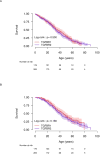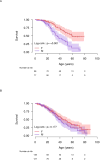International Registry of Patients Carrying TGFBR1 or TGFBR2 Mutations: Results of the MAC (Montalcino Aortic Consortium)
- PMID: 27879313
- PMCID: PMC5177493
- DOI: 10.1161/CIRCGENETICS.116.001485
International Registry of Patients Carrying TGFBR1 or TGFBR2 Mutations: Results of the MAC (Montalcino Aortic Consortium)
Abstract
Background: The natural history of aortic diseases in patients with TGFBR1 or TGFBR2 mutations reported by different investigators has varied greatly. In particular, the current recommendations for the timing of surgical repair of the aortic root aneurysms may be overly aggressive.
Methods and results: The Montalcino Aortic Consortium, which includes 15 centers worldwide that specialize in heritable thoracic aortic diseases, was used to gather data on 441 patients from 228 families, with 176 cases harboring a mutation in TGBR1 and 265 in TGFBR2. Patients harboring a TGFBR1 mutation have similar survival rates (80% survival at 60 years), aortic risk (23% aortic dissection and 18% preventive aortic surgery), and prevalence of extra-aortic features (29% hypertelorism, 53% cervical arterial tortuosity, and 27% wide scars) when compared with patients harboring a TGFBR2 mutation. However, TGFBR1 males had a greater aortic risk than females, whereas TGFBR2 males and females had a similar aortic risk. Additionally, aortic root diameter prior to or at the time of type A aortic dissection tended to be smaller in patients carrying a TGFBR2 mutation and was ≤45 mm in 6 women with TGFBR2 mutations, presenting with marked systemic features and low body surface area. Aortic dissection was observed in 1.6% of pregnancies.
Conclusions: Patients with TGFBR1 or TGFBR2 mutations show the same prevalence of systemic features and the same global survival. Preventive aortic surgery at a diameter of 45 mm, lowered toward 40 in females with low body surface area, TGFBR2 mutation, and severe extra-aortic features may be considered.
Keywords: Marfan syndrome; acute aortic dissection gene; aneurysm; aortic disease; aortic dissection; aortic surgery; diagnostics; genetics; human; peripheral vascular disease; sex differences.
© 2016 American Heart Association, Inc.
Figures




References
-
- Loeys BL, Chen J, Neptune ER, Judge DP, Podowski M, Holm T, et al. A syndrome of altered cardiovascular, craniofacial, neurocognitive and skeletal development caused by mutations in TGFBR1 or TGFBR2. Nat Genet. 2005;37:275–281. - PubMed
-
- Pannu H, Fadulu VT, Chang J, Lafont A, Hasham SN, Sparks E, et al. Mutations in transforming growth factor-beta receptor type II cause familial thoracic aortic aneurysms and dissections. Circulation. 2005;112:513–520. - PubMed
-
- Attias D, Stheneur C, Roy C, Collod-Béroud G, Detaint D, Faivre L, et al. Comparison of clinical presentations and outcomes between patients with TGFBR2 and FBN1 mutations in Marfan syndrome and related disorders. Circulation. 2009;120:2541–2549. - PubMed
-
- Matyas G, Arnold E, Carrel T, Baumgartner D, Boileau C, Berger W, et al. Identification and in silico analyses of novel TGFBR1 and TGFBR2 mutations in Marfan syndrome-related disorders. Hum Mutat. 2006;27:760–769. - PubMed
Publication types
MeSH terms
Substances
Grants and funding
LinkOut - more resources
Full Text Sources
Other Literature Sources

